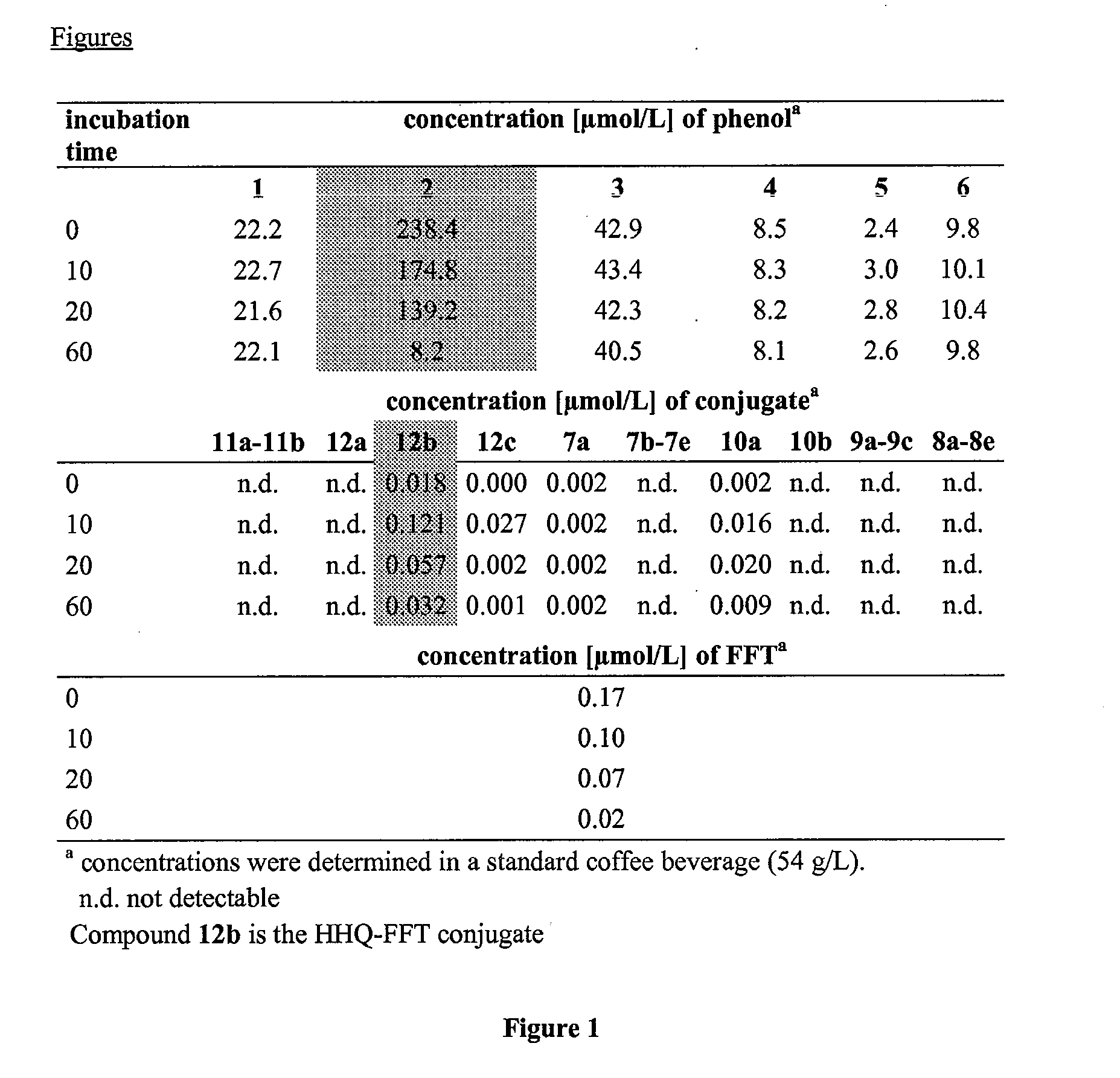Aroma stabilizing method
a stabilizing method and aroma technology, applied in the field of aroma stabilizing methods, can solve the problems of distortion of the overall coffee flavour and flavour compounds, and achieve the effect of stabilizing the aroma of aroma-rich coffee and reducing the amount of phenols
- Summary
- Abstract
- Description
- Claims
- Application Information
AI Technical Summary
Benefits of technology
Problems solved by technology
Method used
Image
Examples
example 1
[0055]54 g of roast and ground (“R&G”) coffee is extracted with water (1 L of a temperature of ca. 95° C.) to form a coffee extract. The coffee extract was analysed for di- / trihydroxybenzenes such as HHQ and free FFT contents as well as the corresponding HHQ / FFT conjugate using the methods described above.
[0056]Table 1 is a table illustrating the change in concentrations of 2-furfurylthiol (FFT), di- / trihydroxybenzenes and phenol / FFT-conjugates during heat treatment of the coffee beverage at 30° C. up to 60 min.
[0057]The phenols tested are 1=pyrogallol, 2=hydroxyhydroquinone, 3=catechol, 4=4-ethylcatechol, 5=4-methylcatechol und 6=3-methylcatechol.
[0058]The concentration of hydroxyhydroquinone (HHQ) in the coffee beverage is 238.4 μmol / L immediately after brewing the coffee. The amount of HHQ decreases by ca. 97% during 60 minutes. The other di- / trihydroxybenzenes are present in the coffee brew in much lower amounts than the HHQ and do not change so much in concentration compared to...
example 2
[0060]A roast and ground (“R&G”) 100% Colombia coffee is extracted with water to form a coffee extract. The extract is passed through a steam stripping column where the volatile flavour / aroma components are stripped, condensed and collected as aroma distillate.
[0061]The HHQ concentration has been measured to give 21.6 mg / l HHQ in the extract.
[0062]This extract is then submitted to a forced oxygen exposure, by bubbling oxygen through the solution (700 ml) with a constant flow rate of ˜20 ml / min. Preferably this treatment is done at elevated temperatures, e.g. 60° C. for up to 2 hours.
[0063]The HHQ concentration has been measured to provide 9.8 mg / l HHQ in the extract as treated above. This corresponds to a decrease of HHQ by approx. 50% in the coffee extract and represent a significant reduction of HHQ compared to the untreated extract.
[0064]The extract was evaporated, aroma added and then dried to a soluble coffee powder using normal process conditions known to the person skilled in...
example 3
[0065]The volatile flavour / aroma components are stripped from a roast and ground (“R&G”) coffee, condensed and collected as aroma distillate. The aroma depleted coffee is then extracted with water to form a coffee extract.
[0066]The pH of the coffee extract is adjusted to pH 8 with an inorganic base, preferably potassium hydroxide, and heated for 90 min at an elevated temperature (e.g. 60° C.) in a closed system. The pH was re-adjusted to the initial value pH 5.2. The HHQ concentration in the treated extract was reduced to 40% compared to an untreated sample.
[0067]After adding back the aroma the resulting beverage was perceived as having a longer lasting aroma with increased freshness compared to the extract without alkaline treatment.
PUM
 Login to View More
Login to View More Abstract
Description
Claims
Application Information
 Login to View More
Login to View More - R&D
- Intellectual Property
- Life Sciences
- Materials
- Tech Scout
- Unparalleled Data Quality
- Higher Quality Content
- 60% Fewer Hallucinations
Browse by: Latest US Patents, China's latest patents, Technical Efficacy Thesaurus, Application Domain, Technology Topic, Popular Technical Reports.
© 2025 PatSnap. All rights reserved.Legal|Privacy policy|Modern Slavery Act Transparency Statement|Sitemap|About US| Contact US: help@patsnap.com

